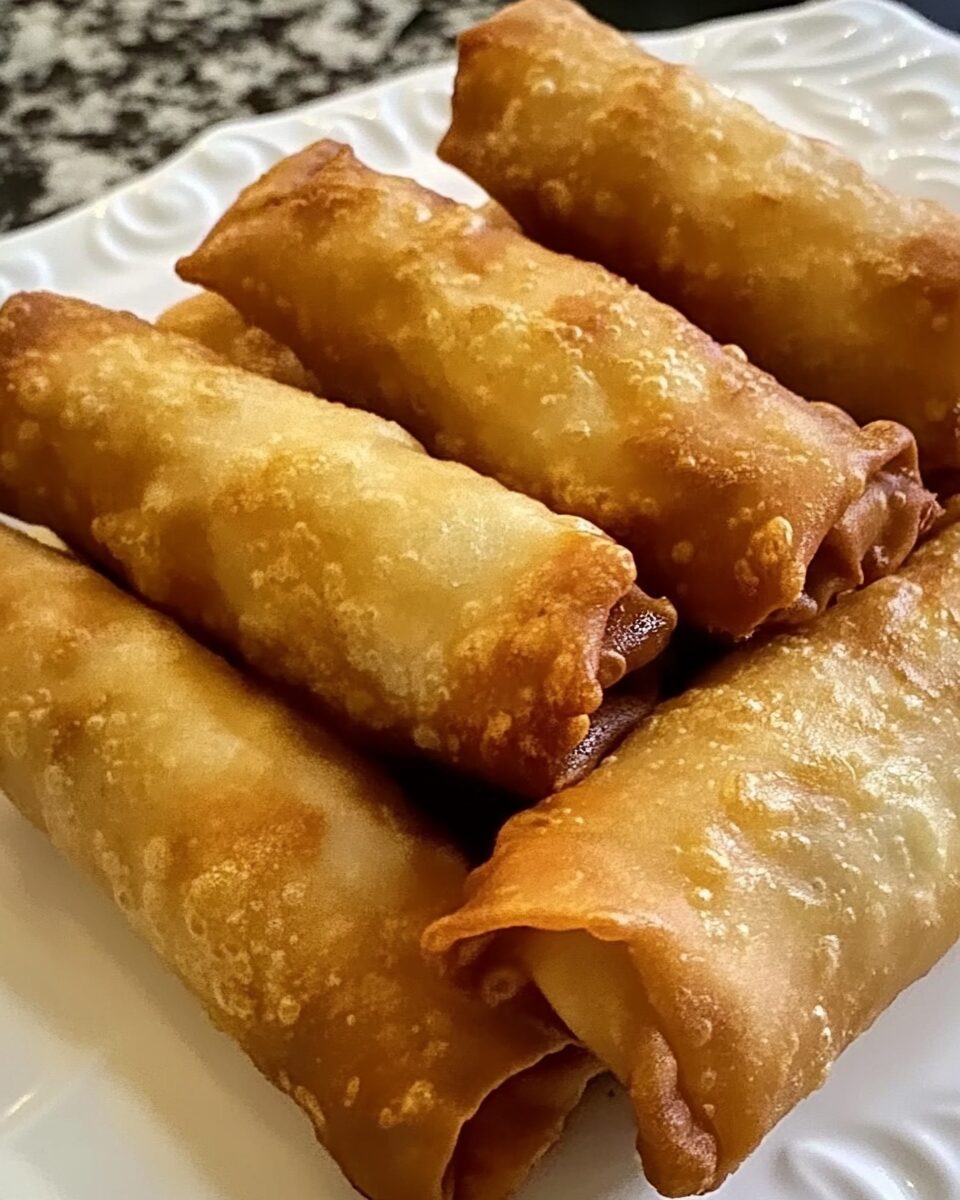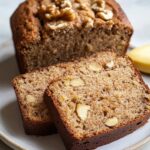These authentic Chinese egg rolls are a crispy and savory appetizer filled with a flavorful mixture of pork, vegetables, and thinly sliced egg. Wrapped in a delicate egg roll wrapper and fried to golden perfection, they make the perfect snack or starter for a Chinese-inspired meal.
Full Recipe:
Ingredients:
- 1 teaspoon vegetable oil (for eggs)
- 2 large eggs, beaten
- 2 tablespoons vegetable oil (for stir-frying)
- 2 cups shredded cabbage
- 1/2 cup shredded carrot
- 1/2 pound ground pork
- 1/4 cup bamboo shoots, finely chopped
- 2 shiitake mushrooms, finely chopped
- 2 green onions, sliced
- 2 tablespoons soy sauce
- 1/4 teaspoon salt
- 1/2 teaspoon sugar
- Pinch of MSG (optional)
- 12 egg roll wrappers
- 1 egg white (for sealing rolls)
- Oil for frying (about 6 inches in a wok or deep fryer)
Directions:
- Prepare the egg strips:
Heat 1 teaspoon of vegetable oil in a wok or large skillet over medium heat. Pour in the beaten eggs and cook without stirring until firm. Flip the eggs and cook for an additional 20 seconds. Remove, cool, and slice into thin strips. - Make the filling:
Heat the remaining vegetable oil in the wok or skillet over high heat. Stir-fry the cabbage and carrot for 2 minutes until wilted. Add ground pork, bamboo shoots, mushrooms, green onions, soy sauce, salt, sugar, and MSG. Cook until the vegetables are softened, about 6 minutes. Stir in the sliced egg. Spread the mixture on a pan and refrigerate for 1 hour or until completely cold. - Assemble the egg rolls:
Place an egg roll wrapper on your work surface with one corner pointing toward you. Spoon about 3 tablespoons of cooled filling onto the bottom third of the wrapper. Brush egg white onto the top two edges of the wrapper. Fold the bottom corner over the filling and roll tightly to the halfway point. Fold in the left and right corners, then continue rolling until sealed. Repeat with remaining wrappers and filling. - Fry the egg rolls:
Heat oil in a wok or deep fryer to 350°F (175°C). Fry 3–4 egg rolls at a time for 5–7 minutes or until golden brown. Drain on paper towels before serving.
Nutritional Facts:
Servings: 12 egg rolls (1 per serving)
- Calories: 160 kcal
- Protein: 6 g
- Total Fat: 9 g
- Saturated Fat: 1.5 g
- Cholesterol: 30 mg
- Sodium: 220 mg
- Carbohydrates: 15 g
- Sugars: 1 g
- Fiber: 1 g
- Iron: 1 mg (5% DV)
What Sets Egg Rolls Apart from Spring Rolls
Although egg rolls and spring rolls are often used interchangeably, they have distinct differences. Spring rolls are a traditional Chinese dish with thin, delicate wrappers made from rice flour, while egg rolls have thicker wrappers that incorporate egg, giving them a sturdier texture and richer flavor. When fried, egg roll wrappers become crisp and bubbly, creating the perfect contrast to their savory filling.
Another key distinction is the filling. Traditional spring rolls often include fresh vegetables and may be served fresh or fried, whereas egg rolls typically feature a hearty mix of cooked cabbage, pork, shrimp, or other proteins. This makes egg rolls a more filling and indulgent option.
The Flavor and Texture of Chinese Egg Rolls
The appeal of Chinese egg rolls lies in their combination of flavors and textures. The outer shell is golden, crispy, and slightly flaky, providing the perfect crunch with every bite. Inside, the filling is savory and rich, often made with a combination of cabbage, pork, carrots, and flavorful seasonings like soy sauce, sesame oil, and garlic.
The filling strikes a balance between sweet and savory, with the natural sweetness of carrots and cabbage complementing the umami notes of the protein and seasonings. When paired with a tangy dipping sauce like sweet and sour sauce or spicy mustard, the egg roll becomes a symphony of flavors that is satisfying and addictive.
The Cultural Popularity of Egg Rolls
Egg rolls have transcended their origins and become a staple in Chinese-American cuisine. They are a favorite item on takeout menus, often served alongside dishes like fried rice, chow mein, or General Tso’s chicken. Their portability and versatility make them a popular snack or appetizer at parties, potlucks, and celebrations.
In addition to their role in Chinese-American cuisine, egg rolls have been embraced by other culinary traditions. Modern variations include fusion recipes that incorporate non-traditional fillings like cheese, avocado, or even dessert ingredients, showcasing the adaptability of the dish.
Tips for Making Perfect Chinese Egg Rolls
- Choose the Right Wrappers: Look for egg roll wrappers that are thin but sturdy enough to hold the filling. Wrappers made with egg provide the best flavor and crispness.
- Prepare the Filling in Advance: The filling should be cooked and cooled before assembling the egg rolls. This prevents the wrappers from becoming soggy.
- Don’t Overfill: Use about two tablespoons of filling per wrapper to ensure the egg rolls cook evenly and don’t burst during frying.
- Seal Properly: Use a beaten egg or water to seal the edges of the wrappers tightly, preventing oil from seeping in during frying.
- Fry at the Right Temperature: Maintain an oil temperature of around 350°F (175°C) to ensure the egg rolls cook evenly and achieve a golden, crispy exterior.
Variations of Chinese Egg Rolls
The classic pork and vegetable egg roll is just one version of this versatile dish. Many variations exist to cater to different tastes and dietary preferences:
- Vegetarian Egg Rolls: These use a mix of cabbage, carrots, mushrooms, and other vegetables, omitting the meat for a plant-based alternative.
- Seafood Egg Rolls: Shrimp or crab can be added to the filling for a luxurious twist.
- Spicy Egg Rolls: A dash of chili oil or diced jalapeños can bring heat to the traditional recipe.
- Fusion Egg Rolls: Ingredients like avocado, cheese, or barbecue chicken give the dish a modern twist, appealing to adventurous palates.
These variations highlight the adaptability of egg rolls, making them suitable for any occasion or taste preference.
Healthier Alternatives for Egg Rolls
While traditional egg rolls are fried to achieve their signature crispy texture, there are healthier ways to prepare them without sacrificing flavor:
- Baked Egg Rolls: Baking the egg rolls in the oven reduces the amount of oil while still achieving a crispy exterior. Brush the wrappers lightly with oil before baking for the best results.
- Air-Fried Egg Rolls: The air fryer is an excellent tool for making egg rolls with less oil. The hot air circulation creates a crunchy texture similar to deep frying.
- Steamed Egg Rolls: While less common, steaming egg rolls provides a soft wrapper and allows the flavors of the filling to shine.
These methods not only make the dish healthier but also add versatility, catering to different dietary needs.
Pairing Egg Rolls with Dipping Sauces
Dipping sauces play a crucial role in enhancing the flavor of egg rolls. Sweet and sour sauce, hoisin sauce, and spicy mustard are classic choices, providing a balance of tangy, sweet, and spicy flavors. For those who enjoy heat, chili oil or sriracha adds a fiery kick.
Homemade sauces allow for endless customization, letting you adjust the flavors to suit your preferences. A simple soy-based dipping sauce with sesame oil and rice vinegar can complement the rich flavors of the egg rolls without overpowering them.
Why Egg Rolls Are Perfect for Any Occasion
Egg rolls are a crowd-pleaser, making them ideal for parties, family dinners, or casual snacking. Their crunchy exterior and savory filling appeal to people of all ages, and their versatility means they can be adapted to suit any menu or theme.
Whether served as a starter for a Chinese-inspired meal or as a standalone appetizer, egg rolls bring a sense of fun and indulgence to the table. Their bite-sized nature makes them easy to enjoy in social settings, and their vibrant flavors ensure they are always a hit.
Conclusion
Chinese egg rolls are more than just a dish—they are a symbol of cultural adaptation, creativity, and flavor. Their crispy, golden exterior and savory filling make them an irresistible treat, whether enjoyed as a snack, appetizer, or part of a larger meal. Their adaptability to various fillings, cooking methods, and dietary needs ensures they remain relevant and beloved by people worldwide.






